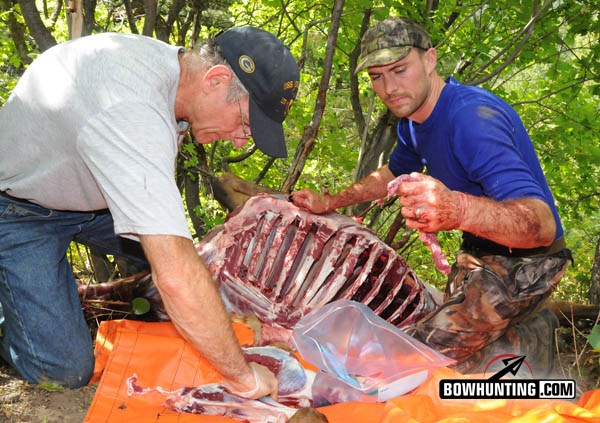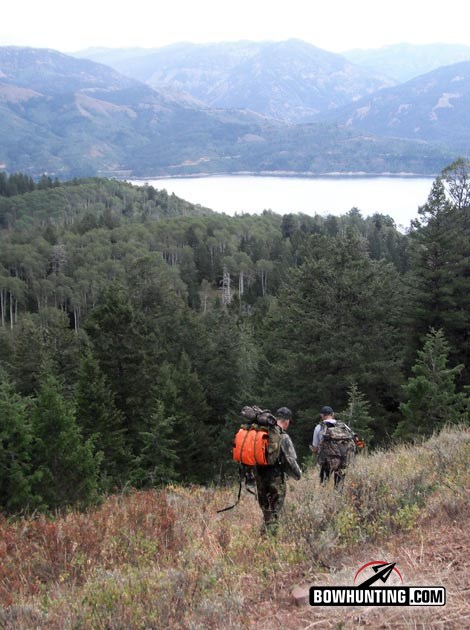LAST UPDATED: May 8th, 2015
SODA SPRINGS, Idaho – Two blue coolers sit in the shade at camp’s edge, crammed with the heart, liver, tenderloins and several-score pounds of other meat we hauled off the mountain Sunday when Karl Malcolm bow-killed his first elk.
After reviewing topographical maps, we decided Malcolm arrowed the cow about 2 miles and 1,600 feet above our campsite, which sits at 5,500 feet of elevation. Just to make sure we earned her meat, the cow ran 120 yards down the mountain’s far side before collapsing in the first bushes stout enough to block her 500-pound body from sliding farther.

Karl Malcolm admires the cow elk he arrowed Sept. 11 in southeastern Idaho.
As Mark Endris and I congratulated Malcolm at the kill site, I reminded him he broke camp policy: “I told you not to hunt any higher and farther than the saddle. We figured 1-1/2 miles and 1,200 feet above camp is far enough to pack an elk.”
He just smiled and said: “I heard a bugle up here. I had to follow.”
I dropped the subject, hating to sound like a grumpy 55-year-old scolding an eager pup of 29.
“Well, tell the story,” I said. “What happened?”
Patrick Durkin, left, and Karl Malcolm bone out Malcolm’s cow elk.
Malcolm had sat on a ridgeline a mile from camp till 8 a.m. After hearing nothing, he stalked uphill toward the saddle, a flat meadow where two east-west ridgelines converge beneath a steep north-south ridgeline.
Elk cross often feed in the saddle and bed nearby. In fact, two days before, Malcolm got within 53 yards of the “king of the mountain,” a trophy bull no hunter would spurn. Although Malcolm had a clear shot at the bull, he passed it, thinking it too far for a bow and arrow.
Mark Endris, foreground, and Patrick Durkin head back to camp with meat-filled backpacks.
As he returned to the saddle Sunday, with the passed shot’s memory replaying in Second-Thoughts Theater, Malcolm spotted a cow elk feeding downhill. He tried moving in front of her, but never got close enough to shoot.
As that opportunity passed, a bull bugled from atop the north-south ridgeline. Malcolm hoofed uphill several hundred yards to the plateau, and then moved toward the bull’s last sound.
Patrick Durkin inspects a bull elk’s impressive rub.
As he inched over and stalked downhill, he spotted an ear twitch in the brush below. At least three elk were 40 yards away. When they acted nervous and minced northward, Malcolm stooped and trotted downhill, angling to cut them off.
He stopped about 20 yards uphill from the elk, which grew increasingly spooky. Malcolm drew his bow, anticipating they would cross an opening below. He released his arrow when the lead cow stepped out. The arrow and three-blade Muzzy broadhead cleaved both lungs and clattered into the brush below.
After the cow fled and collapsed, Malcolm sat, waited an hour before trailing his kill, and then summoned his packers. Endris and I reached him within two hours, toting freighter-size backpacks, knives, sharpener and large meat-storage bags.
We congratulated him while admiring the elk’s tan hide, rock-rounded hoofs, and chocolate-brown head and neck. After taking photos, we rolled the old girl onto her back so Malcolm could field dress her.
The three-hour job that followed reduced the beautiful elk into a hide, skeleton, gut-pile and more than 250 pounds of boned-out meat. Malcolm and I worked at opposite ends of the elk, filleting its meat and dropping the sweet slabs into 2-gallon plastic bags. As each bag filled, Endris sealed and slid it into our packs’ cargo holds.
A view of Idaho’s elk country.
With the meat removed, Malcolm extracted the elk’s two “ivory” or “whistler” teeth – their canines — and sealed them in a bag for safe-keeping and jewelry. We then adjusted the loads on both freighter packs, and transferred the hide and leftover meat to Endris’ army backpack.
I’ve walked farther distances and lifted heavier weights, but never at the same time in combination. The pack-out took about 2-1/2 hours, most of it down steep, brushy mountainsides, causing constant mental reminders of “baby steps, baby steps.”
We seldom sat to rest, finding it easier to simply bend over and wait as our breathing returned to normal. Darkness greeted us as we stumbled into camp and transferred the meat to the coolers.
I congratulated Malcolm once more, silently praised the elk for her meat, and then welcomed an 8-hour sleep to toast our labors.

 By
By 







